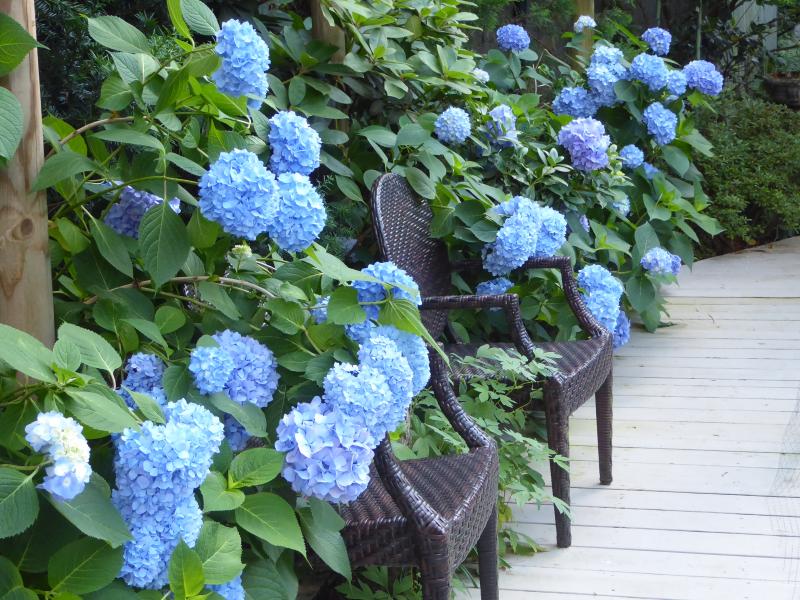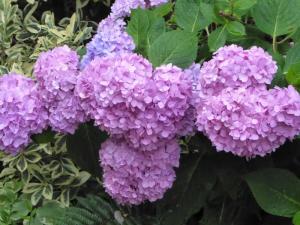Mill Pond Garden welcomes visitors for the spectacular peak of the hydrangea blooming season.
A small, holistic, botanic garden on Red Mill Pond near Lewes, Mill Pond Garden will be open to the public from 10 a.m. to 1 p.m., Sunday, June 21. This wonderful floriferous time, the day after the summer solstice, reveals the glory of many varieties of hydrangea, as well as lilies, daylilies, astilbe, phlox, and the everblooming crape myrtle Rhapsody in Pink. To subscribe free to request an invitation and admission ticket, go to www.millpondgarden.com.
The hydrangea collection is large and diverse, offering an opportunity for homeowners and gardeners to see good choices and get ideas for landscaping.
An old favorite garden shrub, hydrangeas are a backbone of summer gardens. Their large, opulent flowers in white, pink, red, coral, blue or purple are amazing treats for the eye. Many gardens in the Cape Region have at least one, for good reason. Hydrangeas bloom longer than many other shrubs, very generously, from late spring through summer. Often they carry their round or panicle flower heads through color changes not just into fall but, as dried flowers, into winter, providing architectural form.
Mill Pond Garden has a collection of most of the types of hydrangea that can be easily grown locally. The garden avoids growing plants that have compromising problems.
For the home gardener, choices come down to best cultivars as well as sun, shade, desired color, soil preparation for planting, good drainage and mulching. Hydrangeas need good drainage but hate drying out, so mulching with 3 inches of pine bark is recommended. Hardwood bark mulch is high in toxic heavy metals and is not recommended for gardens.
The main types available are hydrangea macrophylla (big leaf), hydrangea paniculata (peegee), hydrangea arborescens (native), and hydrangea quercifolia (oakleaf). There are many common names including lacecap, mophead, oakleaf, French, florist and smooth. There are 26 different species of hydrangea, some of them hybrids, and scores of cultivars of the most popular species.
Mill Pond Garden recommends all hydrangeas be planted in well-drained soil with several shovels of quality compost dug in. The best is horse manure from a local stable.
The most common type, hydrangea macrophylla, likes morning sun and some afternoon shade. To make their flowers bluer, add six shovels of peat moss and a cup of aluminum sulfate to acidify the backfill soil at time of planting. To make flowers pinker, add three to four cups of garden lime to make the soil more alkaline.
All the other kinds of hydrangea like as much sun as they can get, at least seven hours to flower well. The truth is they tolerate shade rather than prosper. Many of the old-fashioned florist type hydrangeas are not good choices for the Cape Region – they flop open, get black leaf spots, dislike the heat and sun, or have their flower buds killed in hard winters. Mill Pond Garden’s recommendation is to keep it simple and go with the proven best choices by specific names.
For named cultivars available in local nurseries, Mill Pond Garden recommends the following.
Hydrangea macrophylla, for part shade, with varieties in lacecap (flat flowers), or mop (round flowers). The best cultivar choice is Endless Summer, a repeat bloomer mop head, available in blue or pink flowering cultivars, and Twist-n-Shout, a lacecap type. Other good mop heads are the dwarf City Line hydrangeas series in bright colors, and slightly smaller shrubs, bred in Germany.
Hydrangeas are best not pruned until new growth is well out in spring; then only dead canes need to be removed. People often think they should cut them to ground in winter, but in spring they get lots of new canes but only leaves, no flowers. Macrophylla hydrangeas bloom on buds set in the previous year. Cutting off the canes removes all the flowering for the current year unless it is a repeat bloomer, and even then fewer flowers bloom very late in season.
Hydrangea arborescens, Incrediball, likes full to part sun, has huge round white flowers totally covering the shrub, grows to six feet, is super hardy with flower buds surviving the worst area winters, and attracts butterflies and other pollinators. This hydrangea is native to North America. All of the arborescens type need a steel stake set close to the middle of the shrub to secure ends of a sturdy string looping out to support the canes, to keep them from flopping open, an ugly look. This is the only flopping hydrangea that is worth the effort of staking, and well worth it, for its spectacular bloom. Another beauty of the Incrediball is its very white canes in winter, which shine with the sun upon them.
Hydrangea paniculata likes full or at least seven hours of sun, has pointy white flowers that often turn pink for a while, is fragrant, attracts pollinators, and has two excellent garden cultivars including Limelight which grows to 10 feet tall and bears white flowers from midsummer to fall, and Vanilla Strawberry, up to seven feet tall, which bears large clusters of white flowers that fade to strawberry pink from midsummer to autumn.
Hydrangea quercifolia, the oak leaf hydrangea, likes part shade to sun but blooms heaviest in full sun. The best cultivar is one of the smaller sizes, Ruby Slippers, up to six feet tall, with abundant pointy white flowers, attracting lots of pollinators. The flowers turn pink then deeper red in fall, with beautiful maroon fall foliage. The oak leaf hydrangeas all have nicely exfoliating bark with great winter interest.

























































